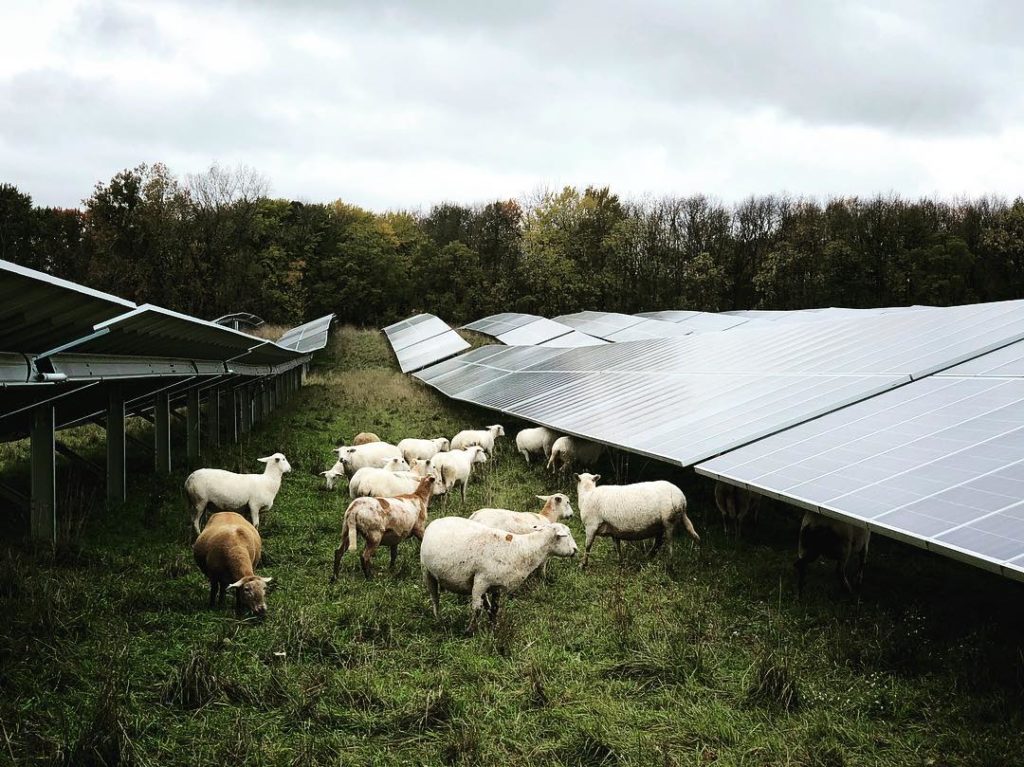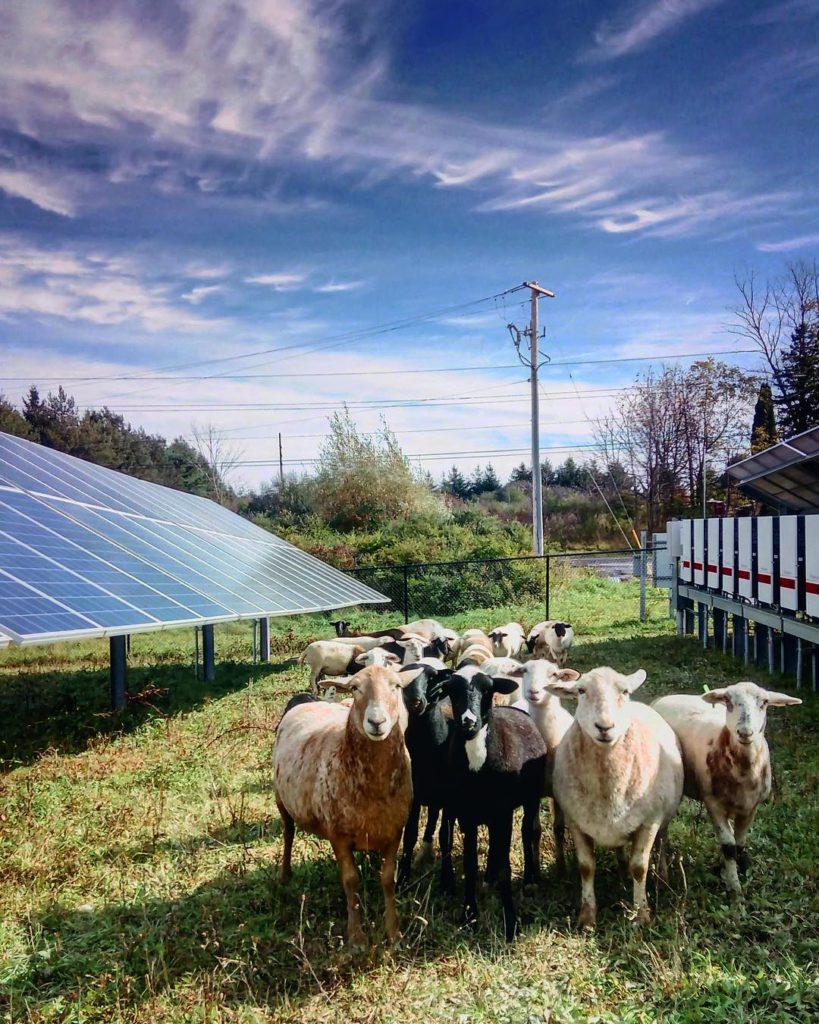Solar Grazing: Livestock as Landscapers at Utility-Scale Solar Arrays
Solar grazing is the use of livestock to maintain vegetation under solar panels.

Solar grazing should be a positive value-add to a sheep enterprise.
Courtesy of Lexie Hain
Utility-scale solar arrays may cover 3 million acres across the US by 2030, according to the National Renewable Energy Lab (NREL). This is causing tension with farmers and farmland advocates, as the panels are often sited on good ag land, displacing current production. One solution is to restrict solar developments from being installed on farmland. But there are other solutions worth pursuing too. Most large-scale solar arrays are located in rural areas where economies are hurting and farmer numbers are dwindling. Therein lies an opportunity for a new income stream for farmers, a way to keep the land under all those solar panels in agricultural use, and a strategy to solve the problem of vegetation management for solar developers.
Solar grazing is the use of livestock to maintain vegetation under solar panels. It is just one practice under the larger umbrella of “agrivoltaics”: combining agricultural and renewable energy production on the same piece of land. Other agrivoltaic practices include producing hay, vegetables, berries, and honey at solar sites. We are only going to focus on solar grazing, and over the next 2 articles, we’ll offer best practices, profiles of successful solar graziers, and resources for getting started.
Why would a solar developer choose to work with you rather than just hiring a landscaper? Reduced cost is one motivation to hire a grazier over a mower. A 2018 Atkinson Center report by Cornell University researchers summarized survey responses submitted by solar graziers, concluding that utilizing sheep for site vegetation resulted in “2.5 times fewer labor hours than mechanical and pesticide management on site.” Other companies may choose to contract with a solar grazier because it is an opportunity for good publicity: because grazing can be compatible with pollinator habitat, to appease the local farming community, or because there are financial incentives (currently only in MA, but likely to be emulated by other states in coming years).
What pay can a solar grazier expect? This varies so much that it is hard to generalize. We will share one detailed example as well as the numbers from the 2018 Cornell University report referenced above in our next article in this series. Solar grazing should be a positive value-add to a sheep enterprise, especially considering that you still get to market all your lambs at the end of the season, and having your sheep off-farm for much of the season may afford you the chance to stockpile forage or make hay, saving on feed costs. One important note is that you should NOT graze a solar farm for free! You will incur costs in transporting your sheep and managing them while they’re on the solar farm. Solar developers have a budget for site operations and maintenance, so you should be paid for the vegetation maintenance service you provide.

Results from around the world indicate a positive future for solar grazing.
Courtesy of Lexie Hain
Which livestock are most appropriate for solar grazing? Around the world, as the practice of solar grazing continues to spread, sheep are generally considered the best fit. Goats are not appropriate for solar grazing because they are more likely to chew on wires, climb on panels, and generally cause mischief. Some sites are designed with the panels on taller posts, allowing cows to graze the site, but this is rare.
What does it take to be a solar grazier? What questions should you ask yourself before getting into it? If you are going to be managing the sheep yourself, you need to factor in all your management time. You will need some way to transport your sheep to the site, and to have movable panels for handling and loading the flock to return at the end of the season. The solar grazing season is typically late April to late October, so you will need a plan for overwintering the flock–including supplying them with shelter, feed, and water–away from the solar grazing site. While they’re at the solar site, you will need to figure out a way to get water to them. Most solar sites do not have water, so you will likely need to haul in a tote of water. The good news is that the shade under the solar panels provides a high-welfare environment for the sheep, so they will likely drink less than normal.
It’s very important to manage sheep on solar sites for top quality health to avoid losing sheep to parasites, and potentially giving solar grazing a bad name. Good grazing practices are imperative. You’ll need a fence charger and portable electric fencing, and your sheep will need to be moved at least every few days, to allow recovery of the grazed plants. The flock shouldn’t return to the previously grazed paddock for at least 6 weeks, and ideally longer, to avoid being infected with parasites. If you’re new to grazing sheep, it’s a good idea to learn about sheep parasites and how to outwit them with good grazing practices. You have to balance the animals’ health with the vegetation management requirements of the solar site, and it is possible that some occasional additional trimming or mowing may be needed.
Utility-scale solar sites generally have a chain link fence enclosing them, but before agreeing to a grazing contract you should walk this perimeter and make sure it is sufficient to keep your animals in, and keep predators out. You should also get soil testing done and make sure you are not grazing a brownfield site with harmful chemicals in the soil that could have adverse effects on your animals.
The American Solar Grazing Association (ASGA) is a non-profit organization founded by sheep producers to advocate for solar grazing, to educate solar developers and graziers about best practices, and to conduct research on the practice of solar grazing. ASGA holds monthly webinars with people all over the world at the leading edge of solar grazing, and they offer many good resources on their website, including a free template solar grazing contract. If solar grazing sounds like an appealing opportunity, become a member of ASGA to get help connecting with solar developers in your area, and to join their dynamic discussion forum, the Mighty Network, where you can ask questions and learn from other solar graziers.
Results from around the world indicate a positive future for solar grazing. As an evolving practice there is still a lot to learn, but it has tremendous potential to benefit farmers, the land, and the agricultural economy.
Look out for the next installment of this “Solar Grazing” series of articles in the next issue of the Small Farms Quarterly.
This article was originally published in On Pasture. Visit onpasture.com for more great grazing information.

